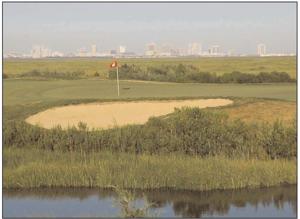A.C. Country Club blends past and present
The 15th hole at Atlantic City Country Club, above, proves to be a serious challenge to even the most experienced golfers. The skydeck, below, is a massive, open-air terrace that is the crown jewel of ACCC's $5 million renovation project.
As for history? It oozes throughout. After all, the place was built in 1897. The Seniors tour was launched here in 1980, when legends like Nancy Lopez, Sam Snead and Arnold Palmer played this course, and future pros like Julius Boros won the Sonny Fraser amateur championship, a grueling multi-day match-play event.
Bob Hope frequented this establishment, as did Mickey Mantle. Leo Fraser, the club owner, had national prestige. He was president of the Professional Golf Association Tour and once brokered an historic peace deal between the players and the organization. Want to go back further? Atlantic City professional John McDermott became the first American to win the United States Golf Association championship, in 1911. And yes, the golf term, "birdie" was invented here.
The past has re-surfaced, captured in a series of recently-recorded videos available throughout the building and in a room honoring Fraser's legacy.
"I did not know all these facts about Atlantic City Country Club at first," says Chip Ottinger, the CEO of the Ottinger Golf Group which purchased the club in 2014. The "Ottinger Empire" also includes Ballamor in Egg Harbor Township and Scotland Run in Williamstown. They are intertwined via membership programs and open to the public in the high-end, daily-fee price range.
"Every course has some kind of history, but there is nothing like what's here," Ottinger says. "We combine the history, preserved with modern technology (videos and kiosks) along with the fabulous views of Atlantic City, and we're thrilled to showcase all of it."
The past and present were further linked last week when Jim Fraser, Leo's son and a member of the previous ownership group, presented Atlantic City Country Club with a painting of its third hole, which had been hanging in his home. Fraser had seen this facility experience ownership changes in the last two decades with the emphasis placed on gaming companies hosting customers. With the Ottinger influence, it again became a golf-first business, with banquet facilities and restaurant amenities added.
"It's great to see what they have done here," Fraser indicates. "It's wonderful to see my family represented in such a nice way and from a golf standpoint, it's back where it was."
The layout includes four tee boxes, ranging from 6,577 to 5,349 yards. Manicured fairways and large sloping greens protected by deep sand bunkers remain a course staple. Long carries over natural marshland and shifting breezes enhance the strategy element of club selection.
Hole nine is considered the toughest, playing 436 yards from the middle tees and requiring two strong shots to reach the green. It's a dogleg left with a narrowing fairway that can come into play off the tee. Four bunkers surround the green. The approach shot must be precise, and lengthy.
The 15th is a formidable challenge, especially from the back tees of 190 yards. It is a par-3 that bends right and is unlikely to bring a straight shot directly to the hole. Strong left-to-right breezes push tee shots toward a dropoff, punctuated by water (confirmed, a little too often, via first-person experience). Many tee shots must start left and allow the wind to push the ball back to the hole. It's hard enough for players to hit a shot straight, let alone steer one. That challenge makes this hole special.
Another difficult par-3 is the 17th, 150 yards from the mid tees, which slopes uphill and is a blind tee shot to the green because of dunes placed in front of the putting surface.
One of the most popular holes is the third, which slopes uphill. It is not a long hole, at 353 yards from the back, but the best tee shot will rest on the left edge of the fairway and flirt with a set of long sand traps on the left. Because traps guard the right-side entrance to the green, the best opening to the green comes from the left side, even though sand is there too.




No comments:
Post a Comment